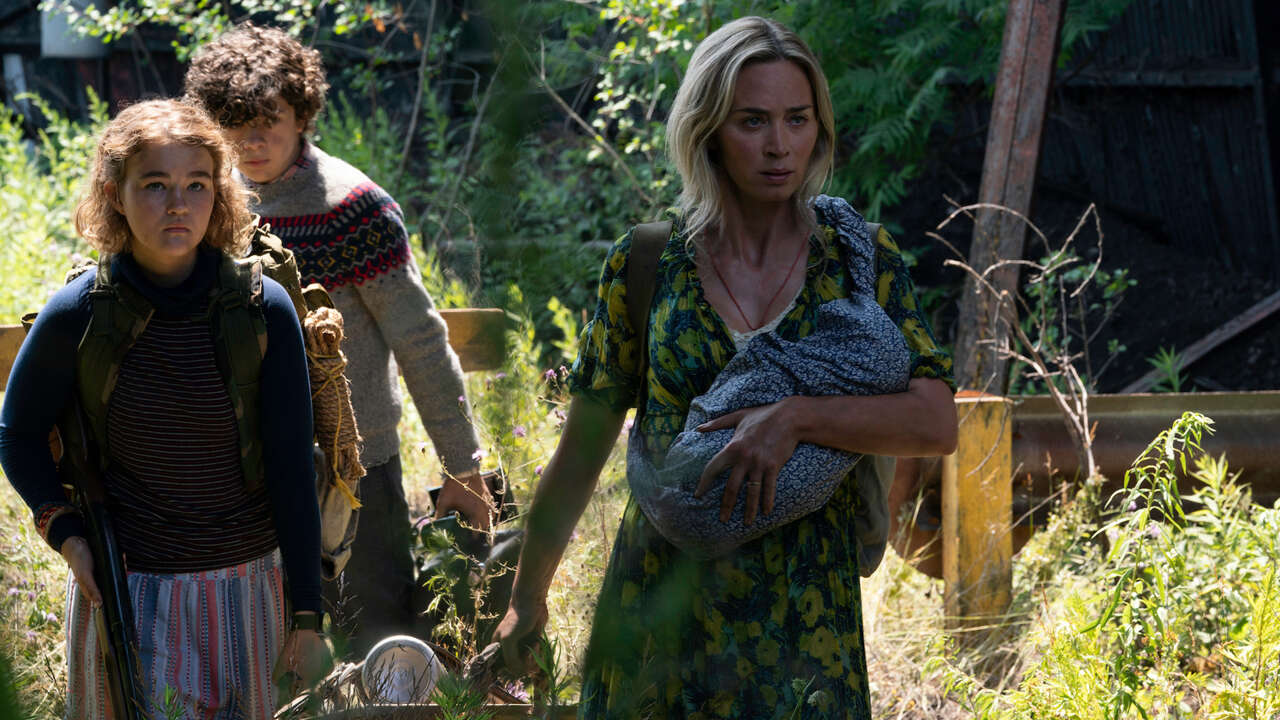
Many of the most effective horror movies work because of a single, clever gimmick. The 2018 hit A Quiet Place used sound as its biggest threat. In this post-apocalyptic monster movie, terrifying but blind alien creatures have invaded the planet and use sound to find their prey. Director and star John Krasinski delivered a tense and scary film focused on a family’s attempts to stay alive by being as quiet as possible–which is not easy when you need to find supplies, give birth, and avoid large nails jutting out from wooden steps.
The sequel, which finally arrives this month after a 14-month delay, is once again directed by Krasinski, who is also the sole screenwriter this time around. Krasinski’s character, Lee Abbott, didn’t make it out of the first movie alive, but he does appear in the opening sequence, which takes us back to the first day of the alien apocalypse. It’s a savage, intense scene that sets the tone for the rest of the movie, as Lee, his wife Evelyn (Emily Blunt), and children Regan (Millicent Simmonds) and Marcus (Noah Jupe) race for safety as their small town is invaded by the huge, multi-limbed creatures.
From there the story picks up moments after the end of the first movie, 18 months after the world ended. Evelyn, Regan, Marcus, and the newborn baby escape their now burning farmhouse and head out into the deserted and dangerous wider world. They soon encounter another local man, Emmett (Cillian Murphy), who lost his family and is now surviving as best he can. At first, Emmett doesn’t want them to stay in the derelict building he is sheltering in, but when Regan leaves the group to go find help alone, Evelyn persuades him to head out into the wilderness to find her.
While the first Quiet Place mixed tense horror thrills with affecting family drama, the sequel puts far more emphasis on the former. The movie does find a few moments of downtime for the beleaguered Abbotts, but for most part this is a stripped-down and intense series of set-pieces, mostly based around the same thing: staying quiet so you don’t get torn apart. The movie runs for just 97 minutes, and is ruthlessly edited to maximise the scares. There are times when a bit more breathing room might have been appreciated, particularly when a community of survivors is encountered later on in the film, but credit to Krasinski for knowing how to keep the tension high by only including scenes that are absolutely necessary. A Zack Snyder movie this is not.
The strength of the cast goes a long way in keeping us invested in the survival of their characters. The first film established a strong, believable bond between them, and Krasinski relies on this natural chemistry. In particular the relationship between the hearing-impaired Regan and her brother Marcus is beautifully performed by Simmons and Jupe, who communicate via sign language. Regan is the movie’s bravest and most resourceful character, and Simmons proves herself to be a charismatic and commanding actor. It’s a shame that Blunt is literally left holding the baby for much of the film, meaning that Murphy gets to do far more of the action hero stuff, as Emmett and Regan embark on their own adventure.
Splitting the group for much of the film is a bold choice, considering the original worked so well with a family unit trying to stay alive in a single setting. But Krasinski really shows his developing skills as a filmmaker here, with some superbly executed cross-cutting ensuring we’re able to stay simultaneously gripped by dangerous encounters in two or three completely separate locations. And while the movie is more interested in scaring us than providing much in the way of character development or world-building, we’re given a look at the world beyond the farm for the first time–and it ain’t pretty. Despite the abundance of post-apocalyptic survivor stories in recent movies and TV, it’s still a shock to see how quickly society has broken down in this world.
Despite the top-notch CGI and impressively freaky creature design–the monsters are no longer kept in shadows–the use of sound remains one of the film’s biggest technical assets. Krasinski will often show how Regan perceives her environment, cutting the audio entirely, before switching back to the sound of the creatures’ terrifying screams and Marco Beltrami’s thunderous score. Emmett and Regan’s attempts to communicate through her lip-reading and his rudimentary sign language also give the movie some of its most touching scenes.
A Quiet Place Part III has already been announced, and while there is definitely more mileage to be had from these characters and this world, it’s hard to escape the feeling that it has affected the way the second film wraps up. In short–it doesn’t really end, it just stops. Which, to be fair, is in keeping with the relentless pacing throughout, and in this era of extended endings and mid-credits scenes, it’s refreshing to watch a movie that is confident enough to simply end. But there are questions remaining that just a few more minutes might have helped resolve and made it all feel less like the penultimate episode of a gripping TV show.
But for the most part, A Quiet Place Part II is the best kind of horror sequel–one that honors the elements that made the first so successful, but instead of simply repeating the formula, finds new ways to keep the story fresh and the scares effective. Krasinski has already handed the reins of the third movie over to Midnight Special’s Jeff Nichols, and it’s unclear whether he’ll stay in horror for subsequent movies as a director. It will be a loss to the genre if this is all we get, as A Quiet Place Part II continues his growth as one of its most skilled filmmakers.
Source: GameSpot

